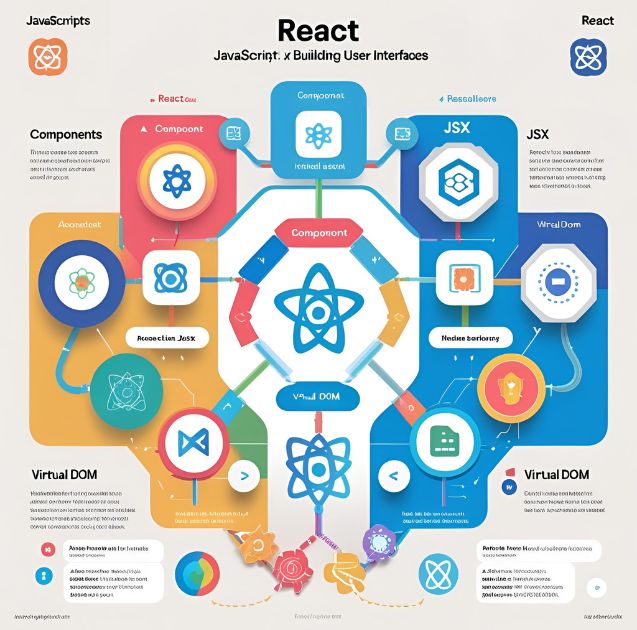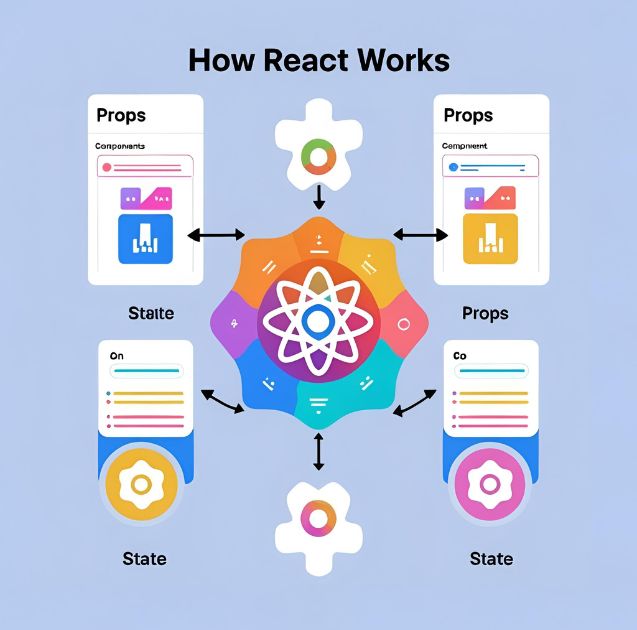React has become one of the most popular tools in web development. Whether you’re starting your coding journey or considering a career change, understanding React can open doors to exciting opportunities in the tech industry.
This comprehensive guide will explain what React is, why it’s so popular, and how you can start using it. By the end, you’ll have a clear understanding of this powerful JavaScript library and whether it’s the right fit for your web development goals.
What is React?

React is a JavaScript library created by Facebook (now Meta) in 2013. It’s designed to build user interfaces, particularly for web applications. Think of React as a toolkit that helps developers create interactive websites and web apps more efficiently.
Unlike full frameworks, React focuses specifically on the “view” layer of applications—the part users see and interact with. It’s component-based, meaning you build your application by creating reusable pieces of code called components.
Here’s a simple analogy: If building a website were like constructing a house, React would be like having pre-made, customizable room modules. Instead of building each room from scratch, you can use these modules and arrange them to create your perfect home.
Why React Became So Popular
React’s popularity in web development isn’t accidental. Several key factors have contributed to its widespread adoption:
Component-Based Architecture
React breaks down complex user interfaces into smaller, manageable pieces called components. Each component is self-contained and can be reused throughout your application. This approach makes code easier to maintain and debug.
For example, if you’re building an e-commerce site, you might create a “Product Card” component that displays product information. You can then use this same component throughout your site—on category pages, search results, and recommendation sections.
Virtual DOM
React uses something called a Virtual DOM (Document Object Model). The DOM represents the structure of your web page, and updating it can be slow. React’s Virtual DOM creates a lightweight copy in memory, figures out what changes need to be made, and then updates only those specific parts of the actual DOM.
This process, called “reconciliation,” makes React applications faster and more responsive than traditional approaches.
Strong Community Support
React has one of the largest and most active communities in web development. This means:
- Extensive documentation and tutorials
- Thousands of third-party libraries and tools
- Active forums where developers help each other
- Regular updates and improvements
Backed by Meta
Having Meta (formerly Facebook) behind React provides stability and confidence. The company uses React for many of its own products, including Facebook, Instagram, and WhatsApp, ensuring continued development and support.
How React Works

Understanding how React works will help you appreciate its power and flexibility.
JSX Syntax
React uses JSX (JavaScript XML), which lets you write HTML-like code within JavaScript. This might look strange at first, but it makes creating user interfaces more intuitive.
Here’s what JSX looks like:
function Welcome(props) {
return <h1>Hello, {props.name}!</h1>;
}
This code creates a component that displays a personalized greeting. The HTML-like syntax is JSX, and the curly braces {} let you include JavaScript expressions.
State Management
React components can have “state”—data that can change over time. When state changes, React automatically updates the user interface to reflect those changes.
Think of the state as the current condition of your application. For example, a shopping cart’s state might include the items currently in it, the total price, and whether the cart is visible or hidden.
Props
Props (short for properties) are how components communicate with each other. They’re like parameters you pass to a function. A parent component can pass data to a child component through props.
This system creates a clear flow of data through your application, making it easier to understand and debug.
React vs Other Web Development Tools
To better understand React’s place in web development, let’s compare it with other popular options:
React vs Angular
Angular is a full framework, while React is a library. Angular provides more built-in features but has a steeper learning curve. React is more flexible and easier to learn, but you might need additional libraries for a complete solution.
React vs Vue.js
Vue.js is another popular JavaScript framework. It’s known for being beginner-friendly and having a gentler learning curve than React. However, React has a larger ecosystem and job market presence.
React vs Vanilla JavaScript
Vanilla JavaScript is plain JavaScript without any frameworks or libraries. While you can build anything with vanilla JavaScript, React makes complex applications much easier to manage and maintain.
Getting Started with React
Ready to dive into React? Here’s how to begin your journey:
Prerequisites
Before learning React, you should have a solid foundation in:
- HTML and CSS
- JavaScript fundamentals (variables, functions, arrays, objects)
- ES6+ JavaScript features (arrow functions, destructuring, modules)
Setting Up Your Development Environment
The easiest way to start with React is using Create React App, a tool that sets up a new React project with all the necessary configuration:
npx create-react-app my-app cd my-app npm start
This creates a new React application and starts a development server. You can then open your browser and start building.
Learning Resources
The React community offers excellent learning resources:
- Official React Documentation: Comprehensive and well-written
- React Tutorial: Step-by-step guide from the React team
- Online Courses: Platforms like Codecademy, Udemy, and freeCodeCamp
- YouTube Channels: Many developers share React tutorials and tips
Common React Concepts to Master
As you learn React, focus on these fundamental concepts:
Functional vs Class Components
React components can be written as functions or classes. Modern React development favors functional components with hooks, which are simpler and more efficient.
Hooks
Hooks are special functions that let you use state and other React features in functional components. The most common hooks are:
useState: Manages component stateuseEffect: Handles side effects like API callsuseContext: Shares data between components
Event Handling
React handles user interactions through events. You can respond to clicks, form submissions, and other user actions by creating event handler functions.
Conditional Rendering
React lets you show different content based on conditions. This is crucial for creating dynamic user interfaces that respond to user actions and data changes.
Building Your First React Application
Start with a simple project to practice React concepts. Here are some beginner-friendly project ideas:
To-Do List
Create a simple task management app where users can add, complete, and delete tasks. This project covers state management, event handling, and conditional rendering.
Weather App
Build an app that displays weather information for different cities. This introduces API calls and data fetching—essential skills for modern web development.
Personal Portfolio
Create a portfolio website to showcase your projects. This helps you practice component composition and responsive design with React.
React in the Job Market
React skills are highly valued in the web development job market. Many companies use React for their web applications, creating a strong demand for React developers.
Career Opportunities
React knowledge opens doors to various roles:
- Frontend Developer
- Full-Stack Developer
- React Developer (specialized role)
- Web Developer
- Software Engineer
Salary Expectations
React developers typically earn competitive salaries. According to various salary surveys, React developers can expect higher-than-average compensation in the tech industry.
Building a Portfolio
As you learn React, build projects that demonstrate your skills. A strong portfolio with React projects can significantly improve your job prospects.
The Future of React
React continues to evolve with regular updates and new features. The React team focuses on improving performance, and developer experience, and adding new capabilities.
Recent developments include:
- React 18: Introduced concurrent features for better performance
- React Server Components: Enable server-side rendering improvements
- Improved Developer Tools: Better debugging and development experience
Your Next Steps in Web Development
React is a powerful tool that can accelerate your web development journey. Start with the basics, build projects, and gradually tackle more complex concepts. The React community is welcoming and supportive, making it an excellent choice for developers at any level.
Consider joining React communities, attending meetups, and contributing to open-source projects. The skills you develop with React will serve you well throughout your web development career.
Remember, learning React is a journey, not a destination. Start building, keep practicing, and don’t be afraid to make mistakes—they’re part of the learning process.







